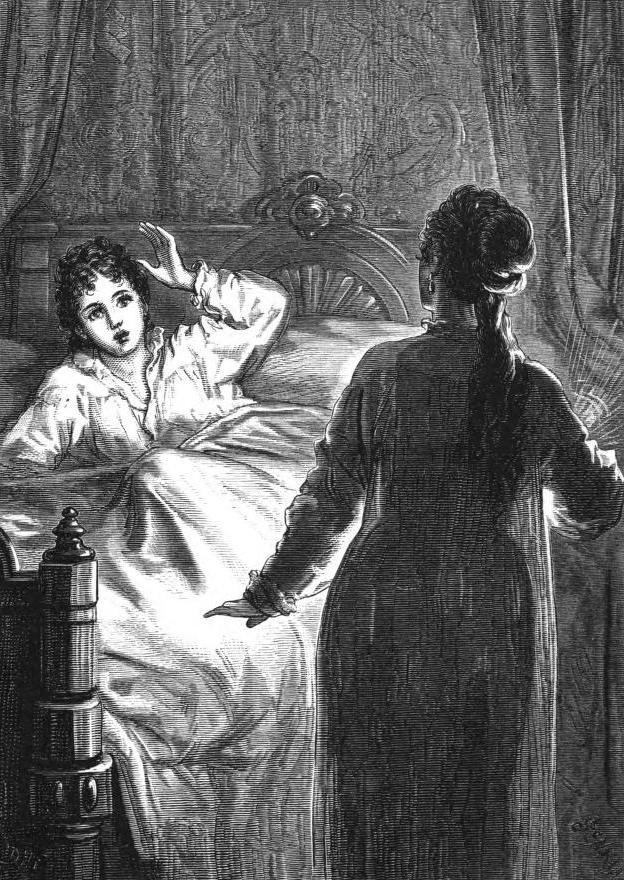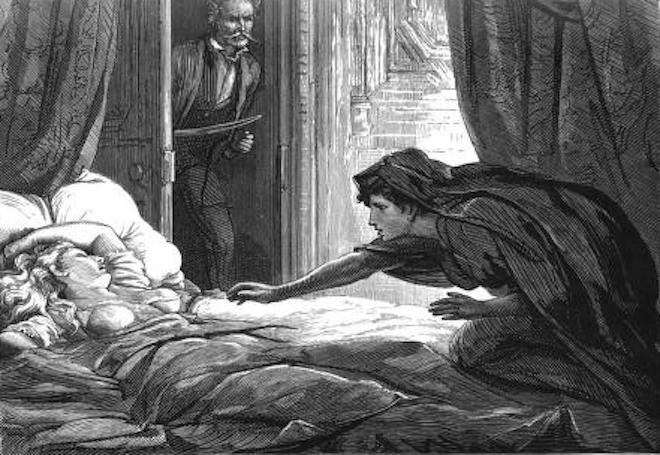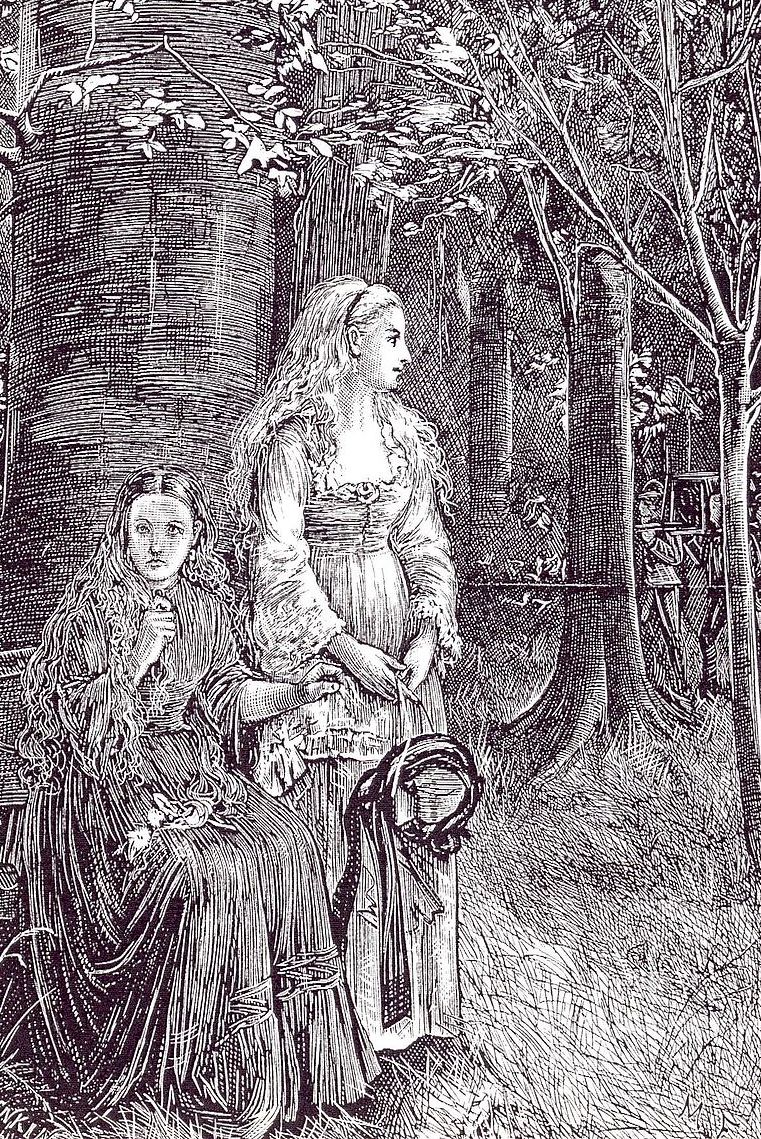 S. Le Fanu’s ‘Carmilla’ (1871–72) is well-known as one of the masterworks of Victorian Gothic. Establishing many of the conventions of the literary vampire, it was a formative influence on the genre’s development in the 1890s: Bram Stoker’s Dracula (1897) was largely a response to ‘Carmilla’, and Le Fanu’s focus on transgressive femininity was one of the sources of M. E. Braddon’s ‘Good Lady Ducayne’ (1892) and Florence Marryat’s The Blood of the Vampire (1897).
S. Le Fanu’s ‘Carmilla’ (1871–72) is well-known as one of the masterworks of Victorian Gothic. Establishing many of the conventions of the literary vampire, it was a formative influence on the genre’s development in the 1890s: Bram Stoker’s Dracula (1897) was largely a response to ‘Carmilla’, and Le Fanu’s focus on transgressive femininity was one of the sources of M. E. Braddon’s ‘Good Lady Ducayne’ (1892) and Florence Marryat’s The Blood of the Vampire (1897).
Still decidedly unsettling for modern readers, ‘Carmilla’’s imagery of Gothic excess and ambiguous sexuality must have seemed outlandish when it was first published with illustrations in the short-lived periodical, Dark Blue (1871), and republished in Le Fanu’s posthumous anthology, In a Glass Darkly (1872). It is impossible to know what fireside readers made of it, but press notices registered a certain disquiet, with one critic observing in The Saturday Review that although for him it was ‘silly and miserable’, it was undeniably ‘offensive’ (‘In a Glass’, Reflections 261).


Two illustrations by D. H. Friston from the Shorter Works (1870-84). Left: 'Carmilla goes into Laura's bedroom', and right: 'Carmilla about to attack Bertha'.
Modern critics have stressed its outré qualities, viewing it as a lightly coded exploration of lesbianism in an age when homosexuality was both misunderstood and proscribed; it is also read as a startlingly unconventional challenge to patriarchal regimes in which, as Elizabeth Signorotti argues, ‘female alliances’ (617) are projected as a means to ‘usurp male authority’ (607). This sort of Feminist analysis is further matched by other interpretations that stress its allegorical qualities as an exploration of British imperialism and the treatment of Ireland, and as a sophisticated reflection, notably in a reading by Helen Stoddart, on emerging ideas of neurosis and the psychology of ‘nervous people’.
Le Fanu’s complicated text stimulates these diverse critiques but, like most of his writing, remains opaque, as uncertain as the suggestive chiaroscuro that features in his many Gothic tableaux. There is unanimity, however, on the text’s evocation of the uncanny, as defined in Freud’s famous essay of 1919. Of course, there is no doubt that its effects belong to ‘the realm of the frightening’ that ‘evokes fear and dread’ (Freud 123): indeed, the grotesque career of the predatory vampire, draining the blood of young women in the form of a ‘monstrous cat’ (‘Carmilla’ 278) or a ‘palpitating mass’ (311) is the very iconography of nightmare and madness. However, the text’s uncanniness is primarily expressed in terms of its unsettling deployment of a version of doubling (Freud 142), in which Carmilla is Laura’s dopplegänger. As Patricia Couglan explains:
Carmilla is of an age with the heroine. They share, and have shared before Carmilla arrived, the same dreams. They do not resemble each other physically, but are represented as two halves of a pair: Carmilla’s dark colouring is the pendent to Laura’s fairness, her vivacity to Laura’s meekness; and her predatory nature to Laura’s submissive one. [151]
Le Fanu constantly emphasises their equivalence, noting how they are of ‘like temperament’, ‘strangely drawn’ together (‘Carmilla’ 260) and essentially ‘one for ever’; as Carmilla remarks to Laura with weighted pronouns, ‘my wild heart bleeds with yours’ (263–64 my italics). This ‘symmetrical duality’ (Cormack 191), though apparently incongruous, is a vehicle to explore Laura’s identity, with Carmilla representing the sexual maturity that she, as an adolescent girl in a narrow social milieu in geographical isolation, aspires to attain. ‘Carmilla,’ Couglan continues, is the mirror-image of Laura’s psyche, the ‘Other of desire’ (151), representing what Freud describes as ‘something that was long familiar’ to the unconscious mind and ‘was estranged from it only through being repressed’ (148). Laura’s ‘homeliness’ (heimlich) is thus fused with Carmilla’s ‘unhomeliness’ (unheimlich), creating a bizarre but menacing confusion.

Carmilla looks back at a funeral in M. Fitzgerald's illustration for the 1871-72 edition of Dark Blue from the University of Chicago library (c1.v.2, facing p. 596).
Such doubling is a sophisticated development of the dopplegänger motif that appears in several of Le Fanu’s fictions, notably ‘The Familiar’ (In a Glass Darkly), in which the protagonist is tormented by a miniaturized version of himself, and in ‘Green Tea’, where the Rev. Jennings’s concealed desires are symbolized (perhaps) by a blaspheming and ever-present spectral monkey. Le Fanu’s bizarre pairing in ‘Carmilla’ further echoes the many uses of the device that appear elsewhere in Gothic literature, linking it with the neo-Platonism of Cathy and Heathcliff in Emily Brontë’s Wuthering Heights (1847) and with the riven character in R. L. Stevenson’s Strange Case of Dr Jekyll and Mr Hyde (1886).
Le Fanu’s treatment of these doubles might also be related to Stevenson insofar as both writers inscribe the idea of duality and pairing in their descriptive imagery, and in their structural organization. It is commonplace to speak of Stevenson’s text in these terms, but it is interesting to note that the Irish author’s deployment of symmetrical binaries, mirroring and dualities has been overlooked. It is clear, however, that Le Fanu supports the central pairing of Laura and Carmilla with numerous small details, while also presenting a half-submerged schema which operates on the principle of balance, antithesis and equivalence.
One important element is Carmilla’s portrait, which acts as another representation of the idea of duality, offering a second, mirror-image of the central character. It also points to the concept of paired antitheses by conflating the dualities of life and death, the present and the past. The painting is apparently an image of the living Carmilla, complete with the ‘little mole on her throat’; yet it is simultaneously an emblem of death, an ‘effigy’ of its subject, ‘blackened by age’ (‘Carmilla’ 272). Simultaneously, the present is juxtaposed to the past as the here-and-now is paired with the painting’s decay and origins – it is dated 1698 – in the far distance (273).
The notion of a sort of twisted mirroring is varied, moreover, in Le Fanu’s treatment of Carmilla’s name. Amy Leal has analysed the text’s onomastics in detail, revealing that the vampire’s moniker is a conflation of opposites: the ‘milla’ stem invokes the Carmelites, the white friars and representatives of godliness, while the ‘car’ part of the name is related to carne – the Italian for meat. This conjunction, Leal argues, brings together holiness and the baser association of flesh and eating flesh – or at least drinking blood (42). The vampire’s bifurcated personality is a similarly doubled in the reversal of her name: sometime known as ‘Carmilla’, in a previous period she is ‘Mircalla’, a near anagram that stresses once more the concept of paired opposites. Indeed, Carmilla’s name and portrait fit next to the pairing of Carmilla and Laura, and create a sort of multiple reflection: the two women represent the halves of one psyche, and the anagram and picture suggest the same combination of opposites.
The emphasis on doubling and symmetry is more generally developed in Le Fanu’s minor details and organization of characters. Though easily missed within his dense pictorialized descriptions, a close analysis reveals an obsessive emphasis on pairs, with practically every item numbered in combinations of two. When Carmilla first appears, for instance, Le Fanu specifies the coach’s formalized doubles, with ‘two horsemen’ in front and ‘two men’ behind; when the vehicle turns over, two of the horses collapse on the ground, and two of the wheels project ‘in the air’ (‘Carmilla’ 252–3); Laura has two governesses and two of Carmilla’s servants were murdered; the General and Laura’s father are two of a kind, as elderly, widowed parents with teenage daughters who give shelter to a mysterious guest in unusual circumstances; the peasants attending the funeral walk ‘two-and-two’ (266); Carmilla’s victims, Bertha and Laura, are twinned, and her other victims are reported as ‘two [more] fatal ones’ (269); the pedlar turns up with ‘two boxes’ (269) and the picture-restorer has ‘two large packing cases’ (271); even time is pressed into a binary frame, with Laura waiting ‘two months’ (249) for Bertha to arrive at the castle. In this fictional world everything is measured in couples – a detail that acts, once again, to frame and emphasise the central couple, whose relationship reproduces the pairing of romantic lovers. Uncannily related, with Laura wondering if they are related, the protagonist and her companion are positioned within a setting in which singularity does not seem to exist; everything has its double. The effect is claustrophobic, as if nothing can exist in plenitude and has to be reduced to a suffocating duality.
The same principle underpins the novella’s structure. Styria is haunted by ‘revenants’ (307) and every action and event is subject to an endless, duplicating return of parallels and symmetrical replication. There is a marked resemblance, notably, between Laura and Carmilla’s life circumstances. Laura notes how Styria is a very ‘lonely place’ (244) far from conventional society, and Carmilla’s ‘native country’ is ‘far more remote’ (266) than Laura had imagined; Laura is an exile from England whose father’s wanderings had resettled them in Austria, and Carmilla and her mother, are (apparently) on a long journey to some distant and unspecified place.
Other key events are similarly patterned into a repeating sequence. Laura’s childhood encounter with Carmilla is matched by her arrival in adulthood, and her bedroom fright as a child is reproduced when the vampire appears in her chamber – the same room – when she is a young woman. Sleeping in their beds when they are vampirized, Laura and Bertha’s experiences are also mirrored, with the amorphous Carmilla acting in exactly the same way in both sequences. The vampire’s arrival and departure are likewise arranged as mirrors of each other as part of a duality, postulating an eerie, reversed symmetry. Carmilla arrives in a carriage that (apparently) crashes, leaving her injured (253); later, she returns to a coffin where she is killed (315). In other words, she emerges from a (wheeled) box at the beginning of the text and returns to a (lead) box at the end: in one, she emerges to live, and in the other she is reduced to a final extinction. This analogy seems to complete the pattern, but Le Fanu closes his tale with a final acknowledgment of the endlessly returning revenant, whose re-emergence pairs with an original appearance: free from bewitchment, Laura still anticipates her return as she listens for Carmilla ‘at the drawing-room door’ (319). The lingering fear frames a text in which, as Laura notes, everything is based on the principle of ‘Ambiguous Alternations’ (319).
Bibliography
‘In a Glass Darkly.’ In a Glass Darkly: Essays on J. Sheridan Le Fanu.. Eds. Gary William Crawford, Jim Rockhill and Brian J. Showers. New York: Hippocampus Press, 2011. 261.
Couglan, Patricia. ‘Doubles, Shadows, Sedan-Chairs and the Past: The Ghost Stories of J. S. Le Fanu.’ In a Glass Darkly: Essays on J. Sheridan Le Fanu. Eds. Gary William Crawford, Jim Rockhill and Brian J. Showers. New York: Hippocampus Press, 2011. 137–160.
Freud, Sigmund. The Uncanny. 1919; rpt. London: Penguin, 2003.
Leal, Amy. “Unnameable Desires in Le Fanu’s ‘Carmilla.’” Names 55 (2007): 37–52.
Le Fanu, Sheridan. In a Glass Darkly. 1872; Oxford: Oxford University Press, 1993.
Le Fanu, Sheridan. The Shorter Works, 1870-1884
. London: Hurt & Blackett, n.d. Internet Archive. Note: Non-sequential page numbers for these gathered publications.
McCormack, W. J. Sheridan Le Fanu. Stroud: Sutton, 1997.
Signorotti, Elizabeth. ‘Repossessing the Body: Transgressive Desire in “Carmilla” and Dracula.’ Criticism 38:4 (Fall 1996): 607–632.
Stoddart, Helen. ‘The Precautions of Nervous People are Infectious: Sheridan Le Fanu’s Symptomatic Gothic.’ The Modern Language Review 86:1 (January 1991): 19–24.
Created 12 October 2022